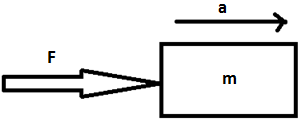
What is kinetic energy? Derive an equation for the kinetic energy of a body of mass ‘m’ moving at a speed ‘v’.
Answer
559.8k+ views
Hint: External work done on any system imparts some energy to the system; this energy is due to either the change in position or change in speed. Energy related to the position is called potential energy and the one associated with the speed is kinetic energy. The kinetic literally means motion.
Complete step by step solution:
Kinetic energy (KE) essentially is the energy possessed by a system or particle due to its speed. It is given by expression
\[KE = \dfrac{1}{2}m{v^2}\]; Here: m is mass of the partial or system and v is the speed.
Derivation of the formula:

Figure shows a particle of mass m under an external force F, which causes acceleration a in the particle. Initially the particle was in rest and as the time passes acceleration causes increase in speed and as a consequence it gains kinetic energy. We can also say that the work done by the force changes into kinetic energy.
For a small time interval we can write;
$dW = dKE = Fds$ ;dW is the small amount of work done, dKE is the small change in kinetic energy and ds is the small displacement of the particle.
We know: $F = ma = m\dfrac{{dv}}{{dt}}$
$
\Rightarrow dKE = m\dfrac{{dv}}{{dt}}ds = m\dfrac{{ds}}{{st}}dv = mvdv \\
\Rightarrow \int {dKE = \int\limits_0^v {mvdv} } \\
\Rightarrow KE = m\mathop {\left[ {\dfrac{{{v^2}}}{2}} \right]}\nolimits_0^v = m\dfrac{{{v^2}}}{2} \\
\Rightarrow KE = \dfrac{1}{2}m{v^2} \\
$
Above is the required relation for kinetic energy, mass and the speed.
Note: The sum of work done by all forces acting on each particle of a system of particle is equal to the sum of change in the KE of each particle of the system. This is known as the “work-energy theorem” and it signifies the “work” as “energy transfer”.
Complete step by step solution:
Kinetic energy (KE) essentially is the energy possessed by a system or particle due to its speed. It is given by expression
\[KE = \dfrac{1}{2}m{v^2}\]; Here: m is mass of the partial or system and v is the speed.
Derivation of the formula:

Figure shows a particle of mass m under an external force F, which causes acceleration a in the particle. Initially the particle was in rest and as the time passes acceleration causes increase in speed and as a consequence it gains kinetic energy. We can also say that the work done by the force changes into kinetic energy.
For a small time interval we can write;
$dW = dKE = Fds$ ;dW is the small amount of work done, dKE is the small change in kinetic energy and ds is the small displacement of the particle.
We know: $F = ma = m\dfrac{{dv}}{{dt}}$
$
\Rightarrow dKE = m\dfrac{{dv}}{{dt}}ds = m\dfrac{{ds}}{{st}}dv = mvdv \\
\Rightarrow \int {dKE = \int\limits_0^v {mvdv} } \\
\Rightarrow KE = m\mathop {\left[ {\dfrac{{{v^2}}}{2}} \right]}\nolimits_0^v = m\dfrac{{{v^2}}}{2} \\
\Rightarrow KE = \dfrac{1}{2}m{v^2} \\
$
Above is the required relation for kinetic energy, mass and the speed.
Note: The sum of work done by all forces acting on each particle of a system of particle is equal to the sum of change in the KE of each particle of the system. This is known as the “work-energy theorem” and it signifies the “work” as “energy transfer”.
Recently Updated Pages
Master Class 11 Chemistry: Engaging Questions & Answers for Success

Master Class 11 Economics: Engaging Questions & Answers for Success

Master Class 11 Accountancy: Engaging Questions & Answers for Success

Master Class 11 Business Studies: Engaging Questions & Answers for Success

Master Class 11 English: Engaging Questions & Answers for Success

Master Class 11 Computer Science: Engaging Questions & Answers for Success

Trending doubts
1 ton equals to A 100 kg B 1000 kg C 10 kg D 10000 class 11 physics CBSE

Which one of the following gases is lighter than air class 11 chemistry CBSE

Earthworms possess hearts A 6 pairs B 4 pairs C 2 pairs class 11 biology CBSE

Proton was discovered by A Thomson B Rutherford C Chadwick class 11 chemistry CBSE

Lysosomes are known as suicidal bags of cell why class 11 biology CBSE

A cockroach has pairs of legs a 2 b 3 c 4 d 5 class 11 biology CBSE




